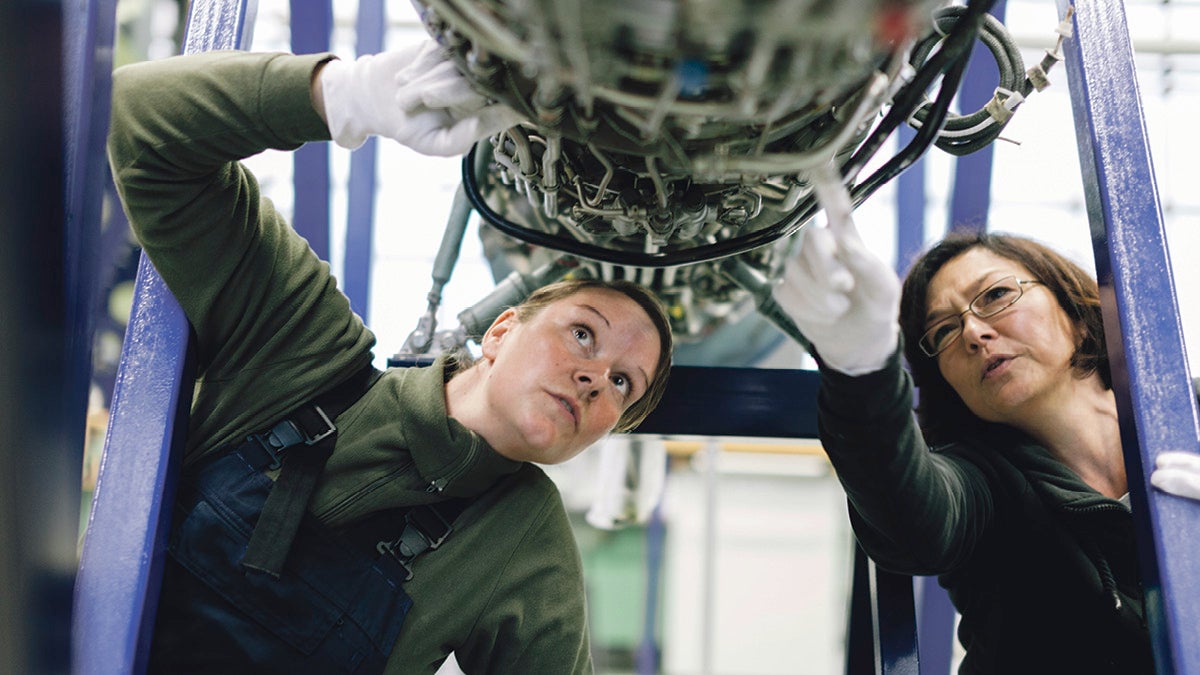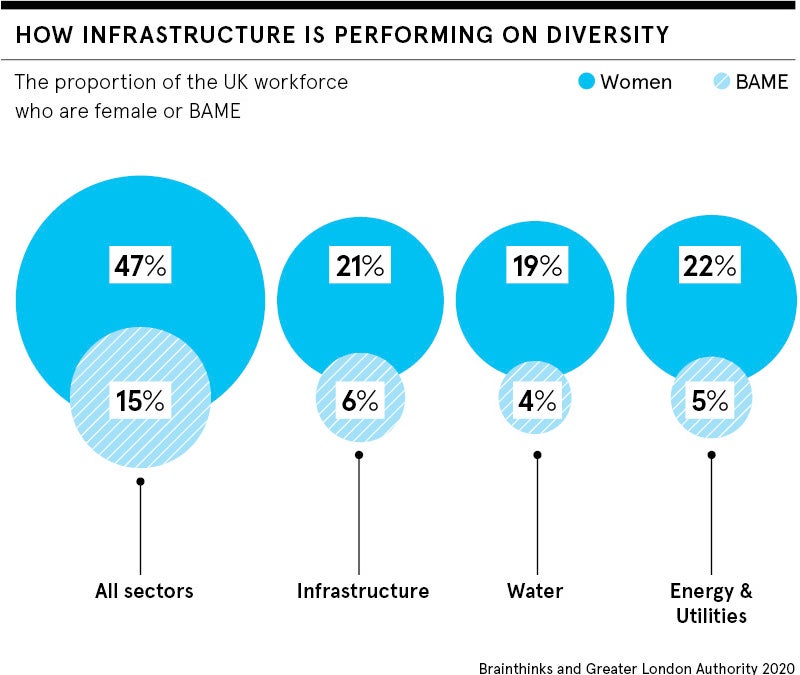
Bolstering economic productivity, tackling the effects of climate change, developing connected communities: truly transformational change through infrastructure needs a laser focus on diversity and inclusion (D&I).
An infrastructure project pipeline worth hundreds of billions, coupled with a skills shortage facing the sector, means there is an urgent need to tap every talent pool.
Traditional stereotypes of the infrastructure industry must be dispelled forever as a new paradigm, embracing the full potential of every current and future employee, emerges, say sector leaders.
“There is a huge pool of talent ruling themselves out,” warns structural engineer Roma Agrawal, who has worked on projects including The Shard and was awarded the MBE for services to the industry.
“Working in infrastructure is fun and important; you see the effect on people’s lives whether that is power networks, sewage systems or roads,” she says. “It is also pretty well paid, so it is sad when young people won’t even consider a career because of outdated stereotypes.”
Last month, the government launched its National Infrastructure Strategy, focused on economic recovery, levelling up regions and achieving net-zero greenhouse gas emissions by 2050.
The strategy also pinpointed the need to diversify Treasury-sponsored agency the National Infrastructure Commission (NIC) and will recruit additional commissioners reflecting diverse talent.
Why diversity in infrastructure matters
Diversity at the highest levels of policy and decision-making is critical to avoid “implicitly building a world that excludes a large proportion of the population”, says Ann Zhang, an economist at PA Consulting and chair of the NIC’s Young Professionals Panel.
“As so much infrastructure is publicly funded, we are also asking people to pay for a world that doesn’t meet their needs,” she says. “We have seen a shift in the infrastructure industry where clients want to see diverse teams with diverse networks, so it is essential to align with the wider market sentiment. Ultimately, it could hit the bottom line and that is powerful.”
Working in infrastructure is fun and important; you get to see the effect on people’s lives
The NIC launched its first D&I strategy in September, setting ambitious targets for itself and the wider industry.
It is measuring success against achieving 50 per cent women, 14 per cent BAME (black, Asian and minority ethnic) and 13 per cent disabled people working within the NIC by 2023, to better reflect society at large.
As well as hitting those targets, the organisation wants to foster an inclusive work environment, by adopting a zero-tolerance approach to bullying and harassment, and planning mental health and wellbeing support.
Cissie Liu, senior regulation analyst at energy company SSE, says there needs to be a step-change so non-minorities are invested in D&I. “The burden should not be on minority groups to drive the change,” she says. “It should come from the top down.”
The talent pipeline needs an overhaul
A major issue impacting the infrastructure talent pipeline is ensuring a more diverse range of people are entering the industry.
At present, only 10.6 per cent of the UK’s professional engineers are women, according to latest data from the Office for National Statistics, although this has increased from 7.6 per cent in 2015. Women make up fewer than a quarter of employees in the water and energy sectors, which also have just 7.1 per cent BAME employees.
The National Centre for Universities and Business found just 15.2 per cent of engineering and technology undergraduates in 2019 were women, highlighting a significant gap in potential new entrants to the infrastructure industry.
Infrastructure is publicly funded; we are asking people to pay for a world that doesn’t always meet their needs
Brittany Harris, co-founder and chief executive of construction technology firm Qualis Flow, says visible role models make a difference. “At school, I knew I wanted to work in science, but when I started looking into engineering, every piece of marketing material showed a white male,” she says. “It was only after meeting more representative role models that I realised these spaces were open to me.”
Concerted efforts are being made by organisations to engage children and young people in the creativity and innovation a career in infrastructure demands.
Network Rail recently ran a nationwide STEM (science, technology, engineering and maths) competition with schoolchildren aged five to fourteen, celebrating the work of female inventors and engineers, and is involved in the annual children’s Leaders Award to create innovative designs that shape the future world.
Director of D&I at Network Rail Loraine Martins, who has also been awarded an MBE, says engaging young people is key to capturing “different ideas to help meet big challenges, such as an ageing population, sustainability and the skills shortage we face in the industry.”
Creating a culture of inclusivity
The next challenge is retention of diverse talent and fostering a culture of inclusivity, allowing employees to be themselves at work, boosting confidence and productivity, and progressing their careers.
Reverse mentoring for executive leaders, where they are mentored by a junior employee from a different background, is dispelling stereotypes around gender, race and sexual orientation at Network Rail.
Six employee networks include Archway, focused on lesbian, gay, bisexual and transgender issues, as well as the disability-focused CanDo, and groups around women, diverse cultures, faith and those with caring responsibilities.
“An unintended consequence of our networks is that we are attracting new employees because we are diverse and inclusive,” adds Martins.
Physical improvements to the work environment, such as toilet facilities, are making a difference for Network Rail, while Thames Water has introduced female-friendly personal protective equipment during the coronavirus pandemic.
Overhauling family leave policies and “promoting male role models who work flexibly or take shared parental leave to break down stigma and ensure a level playing field” is part of a drive to improve gender equality at Thames Water, says culture, inclusion and engagement lead Sarah Gosiewska.
Across the wider industry, celebrating diversity in the workplace has snowballed. The Building Equality alliance of construction consultants, engineers, developers and contractors has swelled to more than 40 organisations driving LGBT+ (lesbian, gay, bisexual, trans and related communities) inclusion in the past five years.

Taking steps in a more diverse direction
Despite slow progress since the government launched its Disability Confident scheme in 2016, around a dozen firms in the infrastructure sector, including HS2, FM Conway and Kier Highways, have now reached the highest leader level, with its requirement to prove they are employing more disabled people.
Thames Water was the first water company to reach Disability Confident leader status as part of wider D&I plans, including attracting women in STEM, advancing ethnic minority talent in leadership and management positions, supporting armed forces communities and becoming a top employer for LGBT people.
“This is not just morally the right thing to do, but also critical to ensuring a high-performing, financially sustainable sector,” emphasises Gosiewska.
For Dr Alice Maynard, managing director of consultancy Future Inclusion and former chair of Transport for London’s independent disability advisory group, who has a CBE, more transformational change is needed in how leaders approach D&I to avoid it being a tick-box exercise.
“But when people actually get it, this becomes a significant priority and they are very creative and flexible in looking at their systems, processes and culture,” she says.
Perhaps the greatest challenge facing all organisations is gathering robust data that allows for identifying diversity gaps and planning a programme of change.
Network Rail’s Martins believes “undersharing” is an issue in gathering data on disability and sexual orientation as people are wary of how the information will be used.
“We know the ethnicity of 87 per cent of our workforce, which has allowed us to talk about the ethnicity pay gap, but we need further data on other minority groups so we can change and improve,” she acknowledges.

Bolstering economic productivity, tackling the effects of climate change, developing connected communities: truly transformational change through infrastructure needs a laser focus on diversity and inclusion (D&I).
An infrastructure project pipeline worth hundreds of billions, coupled with a skills shortage facing the sector, means there is an urgent need to tap every talent pool.
Traditional stereotypes of the infrastructure industry must be dispelled forever as a new paradigm, embracing the full potential of every current and future employee, emerges, say sector leaders.





